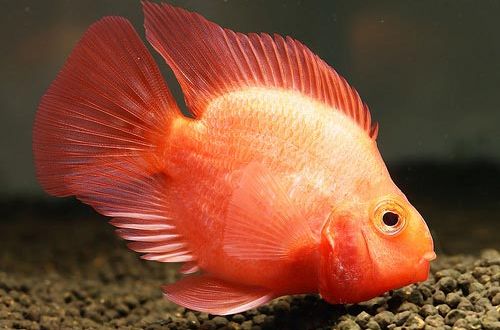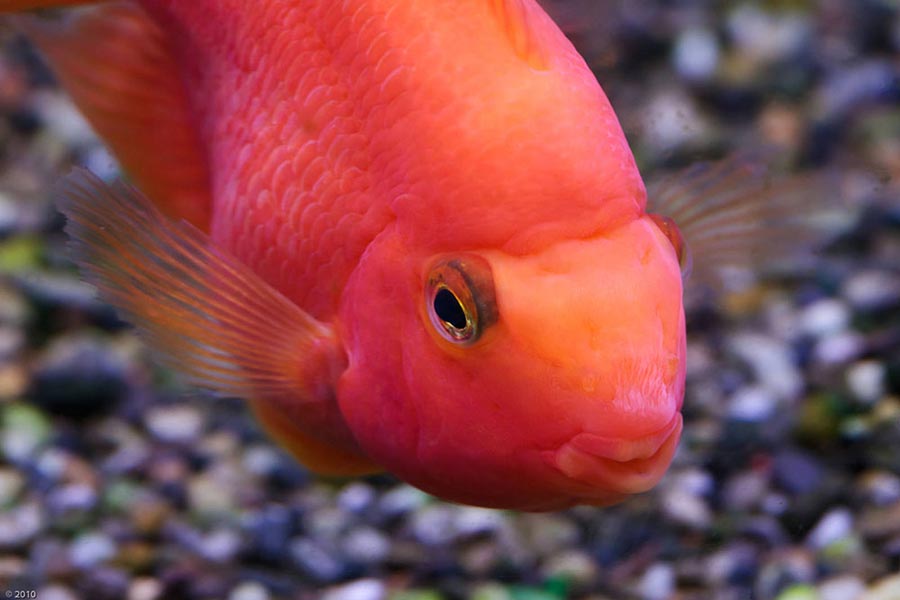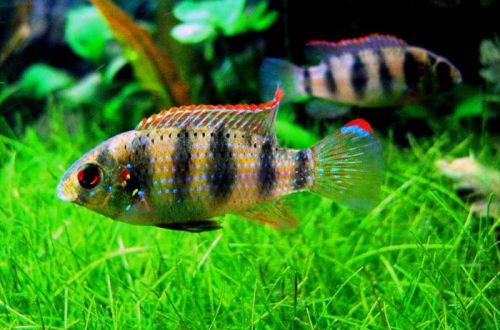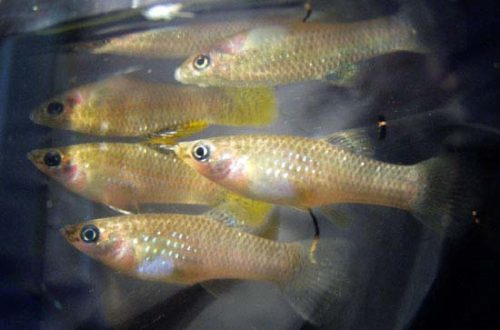
Parrot fish
The parrotfish, popularly known in English as the Blood Parrot, is an artificially bred form from several species of South American cichlids. It has an unusual appearance with a powerful head and a small mouth, reminiscent of the shape of a parrot’s beak.

This species is an excellent candidate for the role of the first fish of a novice aquarist, in addition to an attractive appearance, it also has good endurance and unpretentiousness. Peaceful disposition allows you to keep together with many other calm fish of a similar size.
Requirements and conditions:
- The volume of the aquarium – from 120 liters.
- Temperature – 21-28°C
- Value pH — 6.5–8.0
- Water hardness – from very soft to hard (2-25dH)
- Substrate type – any dark
- Lighting – subdued, moderate
- Brackish water – no
- Water movement is weak
- Size – up to 20 cm.
- Food – any food
- Life expectancy – up to 10 years.
Contents
Habitat
It does not occur in the wild, it was bred artificially in 1986 by step-by-step crossing of several species of South American cichlids.
Description

The parrot fish has a round massive body shape with a pronounced head and a small mouth. The shape is similar to the structure of the beak of parrots. In some cases, in some fish, the mouths do not close or there are difficulties with this, such a feature is the cost of selection. Clumsiness can also be attributed to them, a heavy body makes it difficult to move smoothly, but on the other hand, this can be considered as another highlight of this species.
The color is predominantly yellow, orange or red, other colors are less common (purple, gray, pink, etc.). Wide fins are usually painted in body color.
Food
They consume all types of dry industrial feed and foods with a high protein content. Protein supplements stimulate coloration and are desirable rather than attractive in the diet. It is recommended to purchase specialized food that takes into account the characteristics of the parrot fish, and saving the aquarist from additional hassle in preparing the food. Not all of the food will be eaten, be sure to remove leftovers to prevent water contamination.
Maintenance and care
They are unpretentious in content, withstand wide ranges of water parameters, but the structural features determine a few simple rules. There should be no movement of water in the aquarium, a very weak current is allowed. Fish produce a lot of waste, so a productive filtration system is a must, weekly siphon cleaning of the soil, during this process about 20% of the water should be renewed. The lighting system is adjusted to moderate or subdued light. Other recommended equipment consists of a heater and an aeration system.
In the design, it is preferable to combine free areas with shelters from snags and thickets of plants. Any soil, preferably dark, it will contrast with the color of the fish, emphasizing it.
Social behavior
Peaceful accommodating fish, even somewhat shy. They prefer a society of their own kind from several individuals. May be kept together with other peaceful fish of a similar size. Avoid introducing very active or aggressive species.
Breeding / Reproduction
Fish are difficult to identify by gender. In the presence of a male / female pair, spawning often occurs, but the eggs will be sterile. Breeding at home is extremely rare, it is necessary to have professional knowledge about the selection of this species.
Fish diseases
Many of the diseases characteristic of other tropical fish are characteristic of fish. Health problems usually manifest themselves when conditions worsen, the water is contaminated with waste products, or contact with other sick fish. Sometimes there are problems with the swim bladder, and the fish begins to swim upside down, this can be associated with indigestion due to poor quality or unbalanced food. It is treated by switching to another diet, it is recommended to use specialized food for parrot fish. Read more about symptoms and treatments in the Aquarium Fish Diseases section.
Features
- Produce a lot of waste
- Requires quality food





